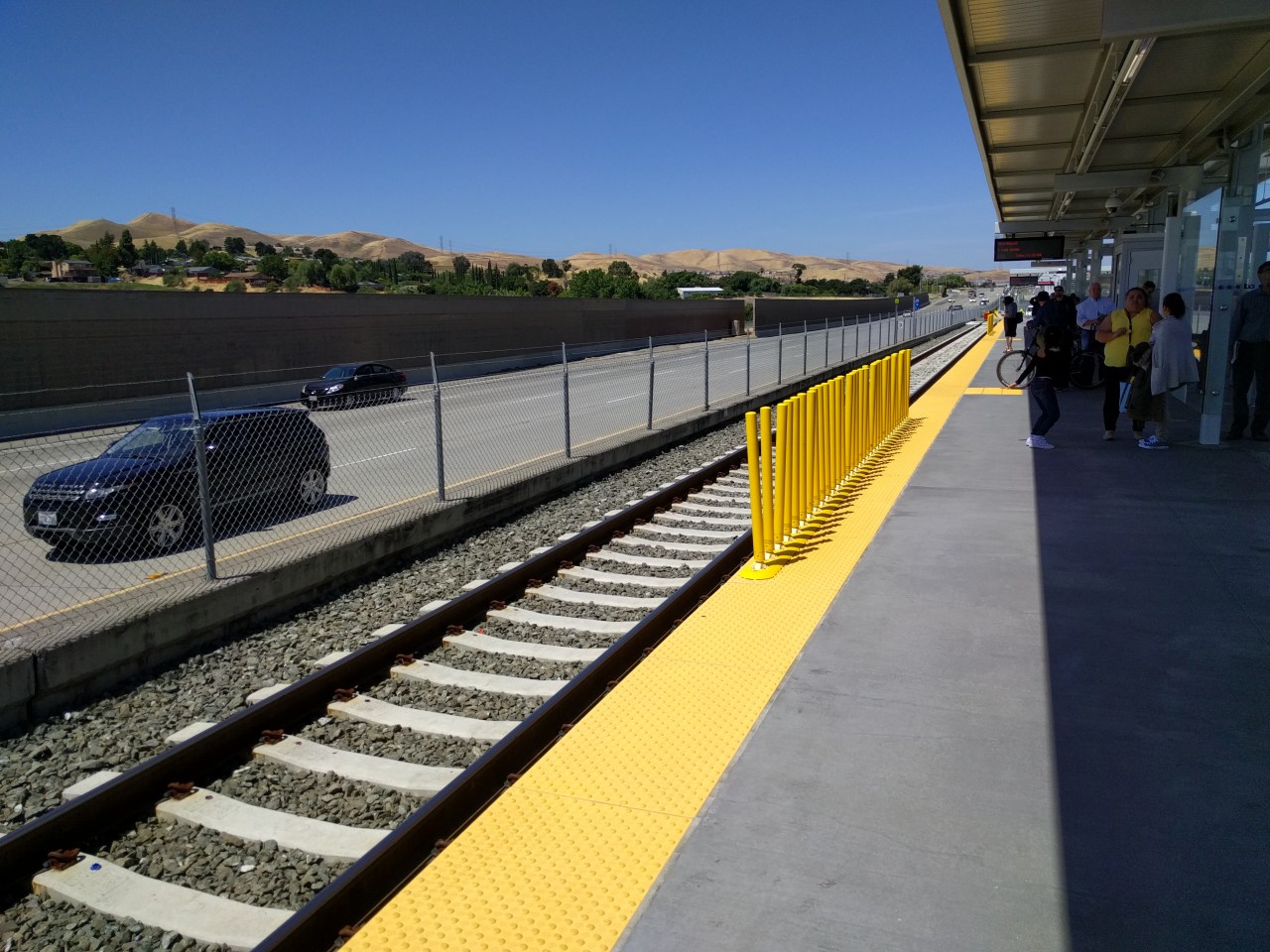A couple weeks ago, folks from TransitCenter and Streetfilms were in Southern California to experience and document Metro's success in expanding rail transit. In the process they also encountered some disappointing aspects of Metro rail. Metro light rail's lack of priority when mixing with car traffic was explored in an earlier post. Today Streetfilms and TransitCenter released a new short documentary about the inhospitable environment at Metro stations located in the middle of Southern California freeways.
Metro's Green Line is the main culprit, with eight of fourteen stations sited in the middle of the 105 Freeway. There are also three Gold Line stations on the 210 Freeway in Pasadena - and five Silver Line Bus Rapid Transit stations in the middle of the 110 Freeway.
Southern California station noise levels have been studied by Metro and by academics. Unfortunately, noise fixes have proved elusive.
In 2009, the year Metro opened the Silver Line BRT, the agency hired ATS Consulting to study noise levels at the 37th Street Station on the 110 Freeway. (The ATS study is not online, but is summarized in the UCLA study below.) ATS found station noise from 78 to 87 dB, which was "not high enough to cause hearing damage even with long term exposure, but... sufficiently high to impede most conversation and cause annoyance." The study recommended sound barriers (more on these below) at the 37th Street Station, which Metro added.
At that time Metro station design guidelines specified a maximum 70 dB noise level. After the study, Metro increased that limit to 75 dB, but the agency has not been able to meet even that relaxed standard.
The UCLA study, Passenger Exposure to Noise at Transit Platforms in Los Angeles by Alexander Schaffer, came out in 2012. Shaffer measured noise levels at all sixteen Metro mid-freeway stations.
Five Green Line stations top the list for worst average noise levels. Pasadena's Gold Line stations had the lowest average noise levels, but still ranged from 78 to 81 dB. Every station fail to meet Metro's 75 dB design limit.
The Occupational Safety and Health Administration recommends sound levels not greater than 90 dB for all workers for an eight-hour day. The National Institute for Occupational Safety and Health recommends exposure not exceed 85 dB for eight hours to "minimize occupational noise-induced hearing loss." People waiting at stations don't spend eight hours there; peak-hour Green Line service is every six minutes, but after 7 p.m. trains arrive every twenty minutes.
The decibel scale is logarithmic, so going from 75 to 85 dB doubles the noise level. The study characterizes 80 dB as "the noise of normal city traffic" and "decibel levels in the high 80’s are comparable to noise from trucks or motorcycles passing nearby." A CityLab article summarizing the study described freeway station noise as like "having like a loud vacuum cleaner running circles around you," though it quotes Schaffer stating that rider exposure to freeway noise while waiting is less a "health problem" than just "pure annoyance."
Schaffer found that station noise varied based on several factors, including:
- Overhead Structures - Stations directly underneath large roadway bridges (Vermont, Lakewood, and Rosecrans) suffer from noise bouncing off the underside of the road directly above. Stations offset from roadways (Hawthorne, Lake) tended to be somewhat better.
- Traffic Speeds - At several stations (Slauson, Lake), the study attributed reduced noise to nearby cars traveling at slower speeds. Less noise from slower-moving traffic may be a double-edged sword, though, as riders may be exposed to greater air pollution from slower moving cars.
Given the high decibel levels at all of these stations, Schaffer recommends avoiding building future stations in freeway medians. As the study notes, this recommendation is important in planning for the Eastside Gold Line extension along the 60 Freeway, as well as the Sepulveda Pass rail along the 405. In addition to noise issues, these freeway stations expose riders to air pollution, and rarely foster a walkable environment compatible with transit-oriented development.
For existing stations, Schaffer recommends noise reduction measures, primarily involving physical barriers between transit riders and nearby freeway traffic. These barriers include benches, sound walls, and enclosed waiting areas. In addition, dampening materials could be added to existing structures (canopies, the undersides of roadways) that riders wait under.
Metro has been installing plexiglass sound walls as part of a pilot noise reduction program.
Station geometry differs between bus and rail. Mid-freeway rail stations feature a single center platform, while mid-freeway bus stations usually feature two side platforms. Generally, at the bus stations there is also less distance between riders and freeway car lanes. These factors make adding soundwalls more effective at bus stations, so Metro has focused the program there, installing plexiglass sound walls at four of five mid-freeway Silver Line BRT stations: 37th Street, Slauson, Manchester, and Rosecrans.
Earlier this year, Metro installed plexiglass sound walls at the Green Line's Harbor Freeway station.
Metro spokesperson Jose Ubaldo stated that Metro currently has no plans for additional sound walls at Green Line stations due to "funding constraints" and because "the noise reduction at the Harbor Freeway Station has not been satisfactory."
Freeway stations are an unquestionably unpleasant aspect of L.A. transit riders' experience. While the freeway noise may be a minor health risk in and of itself, it is one of numerous factors cumulatively impacting the health of low-income Angelenos. Metro cannot fix all of the hazards that combine to adversely impact riders' health, but the agency should take further steps to find effective measures to further reduce annoyingly loud car noise at its stations.
Metro leaders frequently reference "lessons learned" from past projects. The lesson Metro should learn here is to never again locate a station in the middle of the freeway.






